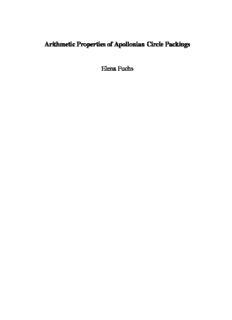
Arithmetic Properties of Apollonian Circle Packings PDF
Preview Arithmetic Properties of Apollonian Circle Packings
Arithmetic Properties of Apollonian Circle Packings Elena Fuchs ABSTRACT. An Apollonian circle packing (ACP) is an ancient Greek construction which is made by repeatedlyinscribingcirclesintothetriangularintersticesinaDescartesconfigurationoffourmutually tangentcircles. Remarkably, iftheoriginalfourcircleshaveintegercurvature, allofthecirclesinthe packingwillhaveintegercurvatureaswell,makingthepackingsofgreatinterestfromanumbertheoretic pointofview. ThispointofviewhasbeenexploredextensivelybyGraham,Lagarias,Mallows,Wilkes, andYanaspartofaseriesofpapersonACP’s.Inthisthesis,weusethecorrespondencebetweeninteger ACP’sandorbitsofacertainSchottkygroupcombinedwiththerecentlydevelopedaffinelinearsieveof Bourgain,Gamburd,andSarnaktoanswermanyofthequestionsraisedbyGrahamet.al.intheiraccount. Acknowledgements There are many people without whose help and support this thesis would not have been possible. Firstofall,Iwouldliketothankmyadviser,PeterSarnak,forintroducingmetothebeautifullysimple problem of Apollonian circle packings and the not so simple affine sieve. He has taught me many important lessons not only about mathematics itself, but also about how to do mathematics and will always remain an inspiration and role model to me as I continue my career in mathematics. Besides my adviser, I heartily thank many of the students, faculty, and staff of the Princeton mathematics departmentfortheiradviceandsupport,bothmathematicalandotherwise,duringmytimeasagraduate student. IwouldalsoliketothankAlexKontorovich,JeffLagarias,AlirezaSalehi-Golsefidy,andKatherine Sanden for many insightful suggestions and conversations about the work in this thesis. Great thanks tomyco-authorofthefourthchapterofthisthesis,JeanBourgain. A warm thank you as always to my wonderful friends and my family Irina, Dmitry, and Katia for theirloveandsupportoverthelastfiveyears. 3 Contents Acknowledgements 3 TheKissPrecise 7 Chapter1. Introduction 9 1. Historyandsetup 9 2. TheApolloniangroup 15 Chapter2. CongruenceObstructions 19 1. ThepreimageΓofAinSL (C) 20 2 2. ThereductionofΓmodulosquarefree(d) 21 3. ThereductionofΓmoduloanyideal(d) 26 4. Congruenceobstructionsfortheorbit 29 Chapter3. Sieving 37 1. Theaffinesieveandtheimportanceofexpanders 37 2. Badprimes 40 3. 28-almostprimepoints 44 4. Aprimenumbertheorem 50 Chapter4. DensityofCurvatures(jointwithJeanBourgain) 65 1. Apreliminarylowerbound 67 2. Countinginseveralsubpackingsatonce 70 Chapter5. Appendix 81 Bibliography 83 5 The Kiss Precise Forpairsoflipstokissmaybe Involvesnotrigonometry. ’Tisnotsowhenfourcircleskiss Eachonetheotherthree. Tobringthisoffthefourmustbe Asthreeinoneoroneinthree. Ifoneinthree,beyondadoubt Eachgetsthreekissesfromwithout. Ifthreeinone,thenisthatone Thricekissedinternally. Fourcirclestothekissingcome. Thesmallerarethebenter. Thebendisjusttheinverseof Thedistancefromthecenter. ThoughtheirintrigueleftEucliddumb There’snownoneedforruleofthumb. Sincezerobend’sadeadstraightline Andconcavebendshaveminussign, Thesumofthesquaresofallfourbends Ishalfthesquareoftheirsum. Tospyoutsphericalaffairs Anoscularsurveyor Mightfindthetasklaborious, Thesphereismuchthegayer, Andnowbesidesthepairofpairs Afifthsphereinthekissingshares. Yet,signsandzeroasbefore, Foreachtokisstheotherfour Thesquareofthesumofallfivebends Isthricethesumoftheirsquares. –FrederickSoddy,1936 7 CHAPTER 1 Introduction OneofthemostessentialtoolsinnumbertheoryisthetheoryofautomorphicformsandL-functions (see [45] and [31] for an elegant survey of various applications). For example, several long-standing problemsinanalyticnumbertheoryhavebeenreducedtofindinggoodestimatesforFouriercoefficients of automorphic forms, and so, with or without applications in mind, automorphic forms have been studiedextensivelythroughoutthepastcenturyandarestillofgreatinteresttoday. One major aspect of these tools is understanding the spectral theory of the Laplace operator ∆ on L2(Γ,H), where Γ is classically taken to be a congruence subgroup of SL (R) (more generally one 2 might consider automorphic forms on GL over a number field). For example, it is known that the n baseeigenvalueinthespectrumforsuchgroupsisλ =0,correspondingtotheconstanteigenfunction. 0 In the case Γ = Γ (N), the modular group, Selberg’s eigenvalue conjecture states that there are no 0 eigenvalues0<λ <1/4,andthereareanalogsofthisconjectureinmoregeneralcasesaswell. However,inthecasethatΓ\Hhasinfinitevolume(wecallΓthinifthisisthecase)itisunclearhow thesetoolswouldapplyandmuchlessisknown. Forexample,itisnolongertruethatthebaseeigen- valueis0–infact,theconstantfunctionisnolongersquareintegrableinthissituation! Nevertheless, there is a wealth of diophantine problems which can be rephrased precisely in terms of such a group Γ. In this thesis, we approach a particularly beautiful example of this kind of problem and are able to solve several relevant open questions without relying on automorphic forms – rather, certain rich propertiesofthegroupinquestionallowustomakeuseofthearithmeticanalysisrecentlycarriedout byBourgain,Gamburd,andSarnakin[7]. Thisexampleismeanttoconvincethereaderthatitisvery naturaltoconsiderdiophantineproblemsassociatedwiththingroupsaswellastooutlinethemethods onemightusetoaddressthem. 1. Historyandsetup Consider four mutually tangent circles, one of them internally tangent to the other three as in the first picture in Fig. 1. One might ask whether there is a unique way to inscribe a circle into each of the curvilinear triangles in this picture. In fact, this uniqueness follows from an ancient theorem of ApolloniusofPerga: THEOREM1.1. (Apollonius,circa200BC):Toanythreemutuallytangentcirclesorlinesthereare preciselytwoothercirclesorlineswhicharetangenttoallthree. 9 10 1.INTRODUCTION Apolloniusdiscoveredthiswhileattemptingthedifficulttaskofconstructingmutuallytangentcircles and straight lines using only a straight edge and compass. Coming back to our picture in Fig. 1, Theorem1.1impliesthatthereisauniquecirclewhichcanbeinscribedintoeverycurvilineartriangle produced by the four mutually tangent circles we have constructed (see the second picture in Fig. 1). We now have 12 new curvilinear triangles, each of which can be filled with a unique inscribed circle again. Thisprocesscanbecontinuedindefinitely,andtheresultingpictureisdulycalledanApollonian circle packing (ACP). Given this process of constructing the packing, we say that the original four circlesinthefirstpictureofFig.1areborninthefirstgenerationofthepacking,thenewcirclesinthe secondpictureareborninthesecondgeneration,andsoon. ! Generation 1 Generation 2 Generation 3 FIGURE 1. PackingCircles One can study Apollonian circle packings from many different angles – various properties of the packings are investigated in a beautiful series of papers by Graham, Lagarias, Mallows, Wilkes, and Yan (see [24], [21], [22], [23]). Such packings are certainly of interest in classical geometry – for example,theprocessofproducinganewcircleatgenerationkisinfactequivalenttoreflectingoneof thecirclesbornatgenerationk−1inanothercircleorstraightline(seeSection2.1foradiscussionof this). We are particularly interested in the number-theoretic questions about ACP’s which are addressed extensively by Graham et.al. in [24]. To understand how these questions arise in the context of this purely geometric construction, consider the curvatures, or reciprocals of the radii, of the circles in a given ACP (equivalently one may consider the radii but these quickly tend to zero, so it is more convenienttoworkwiththecurvaturesinstead). ThenumbertheoreticaspectofACP’stracesbackto the following theorem due to Descartes, that the curvatures of any four mutually tangent circles in an ACPsatisfyaquadraticequation: THEOREM 1.2. (Descartes,1643): Leta,b,c,andd denotethecurvaturesoffourmutuallytangent circles,whereacirclehasnegativecurvatureiffitisinternallytangenttotheotherthree. Then (1.1) Q(a,b,c,d):=2(a2+b2+c2+d2)−(a+b+c+d)2=0.
Description: